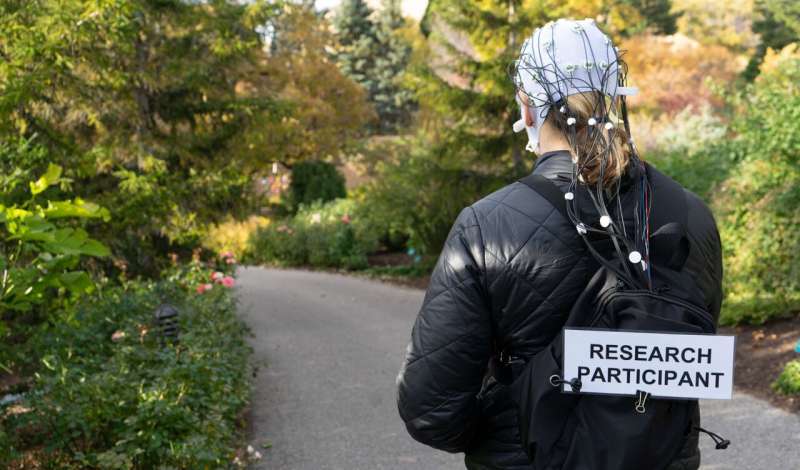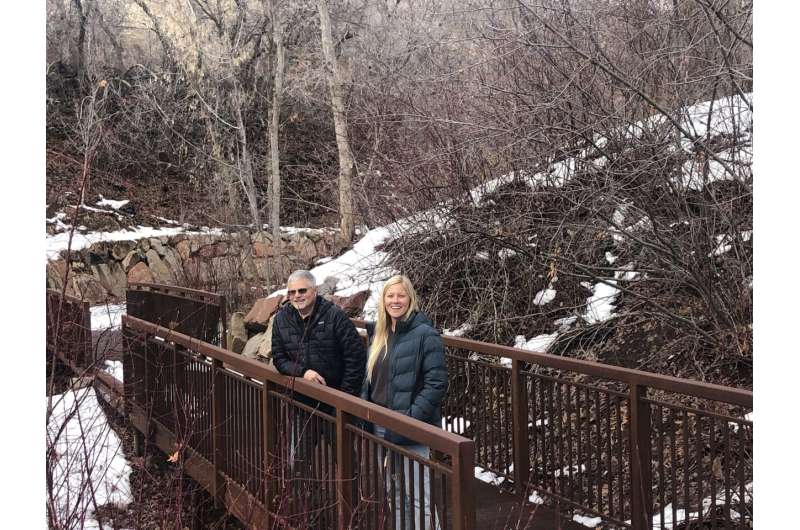This article has been reviewed according to Science X's editorial process and policies. Editors have highlighted the following attributes while ensuring the content's credibility:
fact-checked
peer-reviewed publication
trusted source
proofread
How a walk in nature restores attention

New research from University of Utah psychology researchers is helping prove what American authors John Muir and Henry David Thoreau tried to teach more than 150 years ago: Time spent in nature is good for the heart and soul.
Amy McDonnell and David Strayer are showing it is good for your brain, too. Their latest research, conducted at the university's Red Butte Garden, uses electroencephalography (EEG), which records electrical activity in the brain with small discs attached to the scalp, to measure participants' attentional capacity.
"A walk in nature enhances certain executive control processes in the brain above and beyond the benefits associated with exercise," concludes the study appearing in Scientific Reports. The paper contributes to the growing body of scientific literature on how natural settings contribute to a person's physical and mental health. The university itself has recently established a new research group, Nature and Human Health Utah, that explores these issues and proposes solutions for bridging the human-nature divide.
Many researchers suspect a primal need for nature is baked into humans' DNA, and diminishing access to nature is putting our health at risk.
"There's an idea called biophilia that basically says that our evolution over hundreds of thousands of years has got us to have more of a connection or a love of natural living things," said Strayer, a professor of psychology. "And our modern urban environment has become this dense urban jungle with cell phones and cars and computers and traffic, just the opposite of that kind of restorative environment."
Strayer's past research into multitasking and distracted driving associated with cellphone use has drawn national attention. For the past decade, his lab has focused on how nature affects cognition. The new research was part of McDonnell's dissertation as a grad student in Strayer's Applied Cognition Lab. She has since completed her Ph.D. and is continuing the attention research as a postdoctoral fellow with the University of Utah.
The study, conducted in 2022 between April and October, analyzed EEG data recorded on each of 92 participants immediately before and after they undertook a 40-minute walk. Half walked through Red Butte, the arboretum in the foothills just east of the university, and half through the nearby asphalt-laden medical campus.
"We start out by having participants do a really draining cognitive task in which they count backwards from 1,000 by sevens, which is really hard," McDonnell said. "No matter how good you are at mental math, it gets pretty draining after 10 minutes. And then right after that, we give them an attention task."
The idea was to deplete the participants' attentional reserves before doing the standardized "Attention Network Task" and going for the walk, which they do without their electronic devices or talking to anyone along the way. They are randomly selected to either walk through the least built-up part of the arboretum along Red Butte Creek or through the adjacent U medical campus and parking lots. Both routes covered two miles with similar amounts of elevation gain.
"The participants that had walked in nature showed an improvement in their executive attention on that task, whereas the urban walkers did not, so then we know it's something unique about the environment that you're walking in," McDonnell said. "We know exercise benefits executive attention as well, so we want to make sure both groups have comparable amounts of exercise."
What sets this study apart from much of the existing research into the human-nature nexus is its reliance on EEG data as opposed to surveys and self-reporting, which do yield helpful information but can be highly subjective.
"This is probably one of the most rigorous studies in terms of controlling for and making sure that it's really the exposure in Red Butte," resulting in the observed cognitive effects, Strayer said.
McDonnell fitted each participant with a cap with holes to support an array of 32 electrodes that contacted the scalp with the help of a special gel.
"It has electrodes that are placed all over the surface of the scalp," Strayer said. "It records really very, very small voltages, but it's an active electrode system that provides beautiful brain maps."
The maps revealed three components of attention, alerting, orienting and executive control.

Executive control occurs in the brain's prefrontal cortex, an area critical for working memory, decision making, problem solving and coordinating disparate tasks.
"The kinds of things that we do on an everyday basis tend to heavily use those executive attentional networks," Strayer said. "It's important in concentration and especially, so it's an essential component of higher order thinking."
While the EEG and attention task results did not show much of a difference for alertness and orientation between the garden and the asphalt walkers, those on the nature walk exhibited improved executive control.
McDonnell and Strayer hope the findings can be refined to show what kind of natural settings result in optimal cognitive benefits, and how much exposure is needed to help.
"If you understand something about what's making us mentally and physically healthier, you could then potentially engineer our cities so that they supported that," Strayer said.
The team is continuing the research at Red Butte, but now looking at how cellphone use affects the garden walkers' responses. Strayer is sometimes asked why he studies both distraction and attention, which he sees as opposing sides of the same coin.
"It's where the prefrontal cortex is overloaded, overstimulated, and you make all kinds of dangerous mistakes when you're multitasking behind the wheel," he said. "But the antidote to that is being out in a natural environment, leave the phone in your pocket and then go out and walk the trails. The parts of the brain that have been overused during the daily commute are restored. You see and think more clearly."
More information: Amy S. McDonnell et al, Immersion in nature enhances neural indices of executive attention, Scientific Reports (2024). DOI: 10.1038/s41598-024-52205-1

















